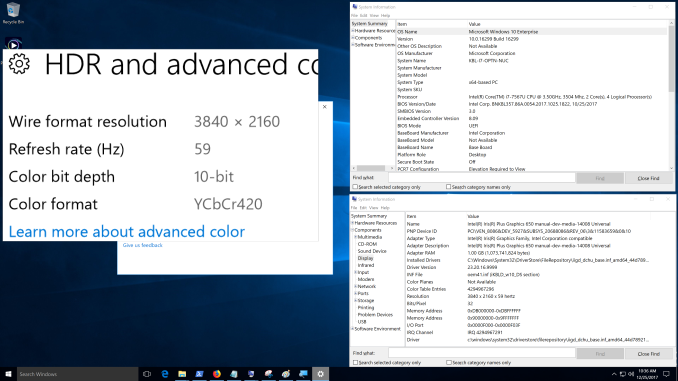A Budget Home Theater & PC Setup: 4K, HDR, UHD Blu-ray, and More
by Ganesh T S on December 26, 2017 8:30 AM ESTHDR Support
High Dynamic Range (HDR) is one of the most impressive features in the recent crop of 4K televisions. In layman's terms, it refers to the ability of a single frame to have wide variation in brightness for different regions. This allows the details in the dimly lit areas of the frame to be seen more clearly. Overall, it delivers a more vivid picture to the viewer. Note that this is quite different from the concept of high contrast.
Picture courtesy: SMPTE HDR Presentation from Steven Holmes of Tektronix
The ability of a display source to transmit HDR frames, as well as that of a display sink to be able to accept and understand them, can be gathered from the HDMI port's specifications. However, being able to accept and understand is only part of the problem. There are many low-cost 'fake HDR' TVs that simply parse the HDR information, but, do not have the ability to translate that to the display.
There are many HDR 'standards', with the base requirement being HDR10. Shifting a display sink into HDR mode involves the source sending some information (metadata) with the characteristics of the video being transported (the mapping of the pixel data to the displayed luminance, light levels in the video stream etc.). If this is static (i.e, done once when the shift to HDR mode occurs), it falls under the HDR10 category. Dolby Vision allows for the metadata to change on a frame-by-frame basis (dynamic). The upcoming HDR10+ standard will also support dynamic metadata. The takeaway is that Dolby Vision certification all but ensures a display with true HDR capabilities.
The TCL 55P607 comes with standard HDR10 and Dolby Vision support. The native Roku apps shift to the appropriate HDR mode based on the content being played back. We will analyze this more in the subsequent sections.
The NVIDIA SHIELD Android TV (SATV) is similar to the native Roku app in the TV with respect to treatment of HDR content. The main issue is that SATV doesn't support Dolby Vision yet, though there is a lot of clamor for it from SATV owners. Videos with HDR10 metadata shift the display to the appropriate HDR mode prior to playback.
PCs encounter additional challenges for HDR implementation. It is just not one company that is responsible for the feature. On one hand, the GPU driver vendors need to support it. On the other hand, the OS itself needs to provide hooks to enable HDR. Finally, the software ecosystem needs to catch up. The Windows 10 Fall Creators Update brought HDR10 capabilities for the Windows desktop into the stable ring. It also allowed streaming of HDR videos from YouTube and Netflix. Microsoft is continuing to fine-tune the HDR capabilities built into Windows 10.
Intel, along with CyberLink, had decided not to wait for Microsoft to deliver HDR on PCs. PowerDVD 17 was the first software Blu-ray player, and it only made sense for them to support HDR playback for applicable titles. The Intel / CyberLink solution for HDR when playing back certain Blu-rays in full-screen exclusive mode is orthogonal to Microsoft's HDR support.
The Windows 10 Fall Creators Update enabled desktop HDR and HDR video streaming on all the three test PCs described earlier.
HDR and Advanced Color Settings - Intel NUC7i7BNHX1 with Desktop HDR Enabled
The KBL-U platforms drove the display at YCbCr 4:2:0 10-bit, while the NVIDIA GTX 1080 drove the HDR output with higher quality (YCbCr 4:2:2 10-bit). For a good desktop experience, 4:4:4 is preferable.
HDR and Advanced Color Settings - Zotac ZBOX MAGNUS EN1080K with Desktop HDR Enabled
Gaming is not a focus in our HTPC reviews, but, we must give credit to NVIDIA for supporting Dolby Vision in their Pascal GPUs. Certain gaming titles such as Battlefield 1 support both HDR varieties (HDR10 and Dolby Vision), and the Zotac EN1080K is able to deliver it in a HTPC environment, thanks to its small form factor and relatively silent liquid cooling.
Battlefield 1 HDR Output from the Zotac EN1080K
Battlefield 1 Dolby Vision Output from the Zotac EN1080K
Unfortunately, Pascal's Dolby Vision support is available only in certain games, and is not applicable to streaming services like Netflix.
Microsoft's current approach to HDR with a desktop HDR mode is currently not efficiently implemented. For example, the desktop in the Zotac ZBOX MAGNUS EN1080K idles at 34.5W. With the HDR mode enabled, this jumps to 39.5W. In the KBL-U systems the penalty is of the order of 0.8W - 1W.















191 Comments
View All Comments
ebilg - Tuesday, December 26, 2017 - link
To avoid all the headaches with UHD Bly-rays you could just get an Xbox instead. The studios don't seem to care about 4K Blu-ray on PCs. Plus the Xbox also does Hulu in 4K.ddrіver - Tuesday, December 26, 2017 - link
It's obvious the "budget setup" isn't actually a budget setup because the guy just accepts to be "sponsored" with equipment that blows any budget: it goes from ~$470 to ~$1000. That's over $500 extra. On a budget! So who cares about the BR player? It can just be sponsored by somebody.@GaneshTS & AT what other budget builds can you do with expensive sponsored stuff? I was thinking on an article on how to get free gaming builds... from your parents.
ganeshts - Tuesday, December 26, 2017 - link
Dude, seriously? The only equipment that was sponsored was the Denon AVR, and it was clearly specified. Everything else was out of my own pocket (other than the PCs that come in for review on a revolving basis)ddrіver - Tuesday, December 26, 2017 - link
That wasn't about getting hidden stuff or anything like that. It was about adding $500 and still calling it a budget build. A $1000 receiver isn't part of any budget build. It doesn't make sense.Gasaraki88 - Wednesday, December 27, 2017 - link
So you want a home theater system but don't want to get an AV receiver? You complaining about a $500 receiver? That's the cheapest you can get that supports DV passthrough and all the other new tech. If you don't want good sound you don't need a receiver so you can subtract that out but then it not a "Home Theater" then.Icehawk - Wednesday, December 27, 2017 - link
Not even remotely true, plenty of recievers in the ~$400 range offer the sams functions. After my last two $800+ recievers crapped out after two years I will no longer put my money in them.Crazyeyeskillah - Thursday, December 28, 2017 - link
You are completely out of touch with your readers. There are plenty of options on the market that will deliver a great experience without dumping $500 into a receiver. While it's fun to piss away money on a home theater system, you don't have to blow all your money on something that won't give a perceivable benefit whatsoever to the average consumer. The extra $500 could make up the difference towards a 55" OLED display, or an entry level projector. Your priorities are clearly bias and deserve to be in question. Most of your articles are fair but this is really a preposterous entry without question.I would have honestly love to seen a review of some entry level projectors. Virtually everyone wants to know more about the bulbs, longevity, brightness, clarity, and other factors. Speakers are pretty much the no brainer of tech, they either work or they don't. If you want more channels just increase the blank.1 you have setup.
Even just building a really versatile box for future proof playback would have been sufficient. People tend to geek out on their displays in their own way.
FreckledTrout - Sunday, December 31, 2017 - link
@Crazyeyeskillah, I disagree. Any adults here who can afford an OLED TV would love a decent quality home theater which will cost at minimum $2000 but many people just don't know it. My nephew who is 28 has a good soundbar system and really didn't understand why I spend $2.5K on speakers and a receiver so we watched a movie, pearl harbor. When your company leans to duck the plane dropping bombs, priceless. Good home theater isn't something most people understand but once they have heard it they know what they are missing.SunnyHours - Wednesday, July 11, 2018 - link
There are other ways of having a decent speaker system without dishing out 500$US on a "home theater" receiver...especially if you don't plan on getting a decent set of Surround Sound speakers, which are not cheap...we are talking at least another 500$ up to 2000$ or more...and just for speakers.Instead, why not get a nice set of powered Bookshelf speakers like AudioEngine, Swan, HiVi, M-Audio, Kanto, Edifier and even Klipsch have good speakers that don't need a Receiver/Amplifier and generally have a 3.5mm cable so it's compatible with most anything, there are also some who do have RCA input(s). In this list you'll find all kinds of prices and whether you want a 2.0 speaker system or a 7.2 speaker system.
Also, another nice option if you have many things to connect, you can always just get a nice and simple 2.1 Sound System with a receiver (NAD, Yamaha, Denon, Harmon Kardon and others that don't come to mind should serve you well) and a pair of regular Bookshelf Speakers (Same brands mentioned before plus a couple others...just go to your biggest audio dealer close by and try them out before you buy them...if you can try both the receiver and speakers all the better!)
The 3rd option would be to go with Headphones!
If you want to head to head, speaker system vs Headphone system...of the same price, you'll always get way more sound for your money out of a simple headphone DAC/Amplifier combo and some Headphones or a DAC, headphone Amplifier and Headphones.
Whatever you do, please, do NOT encourage Bose. They sell overpriced stuff and it's just a really bad deal all around.
If you want more information and to ask questions to people who really know their stuff, head over to the Head-Fi Forums. They really specialize in headphones, but being Audiophiles usually means you'll also want good sounding speakers to be able to share it with others, and also to mix it up a little.
prerich - Friday, July 27, 2018 - link
Bravo!!!!